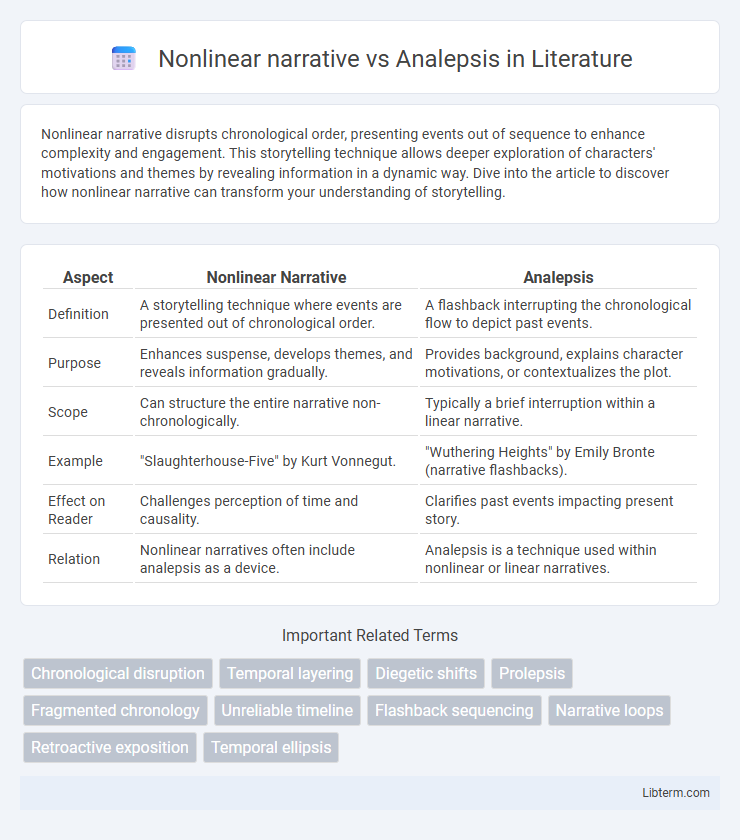Nonlinear narrative disrupts chronological order, presenting events out of sequence to enhance complexity and engagement. This storytelling technique allows deeper exploration of characters' motivations and themes by revealing information in a dynamic way. Dive into the article to discover how nonlinear narrative can transform your understanding of storytelling.
Table of Comparison
| Aspect | Nonlinear Narrative | Analepsis |
|---|---|---|
| Definition | A storytelling technique where events are presented out of chronological order. | A flashback interrupting the chronological flow to depict past events. |
| Purpose | Enhances suspense, develops themes, and reveals information gradually. | Provides background, explains character motivations, or contextualizes the plot. |
| Scope | Can structure the entire narrative non-chronologically. | Typically a brief interruption within a linear narrative. |
| Example | "Slaughterhouse-Five" by Kurt Vonnegut. | "Wuthering Heights" by Emily Bronte (narrative flashbacks). |
| Effect on Reader | Challenges perception of time and causality. | Clarifies past events impacting present story. |
| Relation | Nonlinear narratives often include analepsis as a device. | Analepsis is a technique used within nonlinear or linear narratives. |
Introduction to Nonlinear Narrative and Analepsis
Nonlinear narrative structures disrupt traditional chronological storytelling by presenting events out of sequence, enhancing thematic depth and character development. Analepsis, a specific form of nonlinear narration, involves flashbacks that reveal past events critical to understanding the present plot. Both techniques challenge linear time perception, engaging audiences through complex temporal shifts and layered storytelling.
Defining Nonlinear Narrative in Storytelling
Nonlinear narrative in storytelling refers to a structure where events are portrayed out of chronological order, often to enhance thematic depth or suspense by revealing information selectively. Analepsis, a specific type of nonlinear technique, involves flashbacks that interrupt the main timeline to provide background or context. Employing nonlinear narrative challenges traditional sequential storytelling, enabling creators to explore complex character development and nontraditional plot progression.
Understanding Analepsis (Flashback) Techniques
Analepsis, commonly known as flashback, is a narrative technique that interrupts the chronological flow to present past events, enriching character backstory and plot depth. This method contrasts with nonlinear narrative structures that may rearrange events more freely but often use analepsis specifically to reveal critical information or emotional context. Mastery of analepsis involves seamless integration into the storyline, ensuring clarity while enhancing thematic resonance and audience engagement.
Structural Differences: Nonlinear Narrative vs. Analepsis
Nonlinear narrative refers to storytelling that presents events out of chronological order to create complexity, whereas analepsis specifically denotes a flashback interrupting the primary timeline to reveal past events. Structurally, nonlinear narratives frequently employ multiple temporal shifts, labyrinthine timelines, and fragmented sequences, while analepsis is a singular, bounded deviation that momentarily departs from the linear progression. The distinction hinges on scope and function: nonlinear narratives manipulate overall story structure, while analepsis serves as a focused technique for context or character backstory within a largely linear framework.
Purpose and Function in Modern Literature
Nonlinear narrative structures disrupt chronological order to create complex, layered storytelling that deepens thematic exploration and character development. Analepsis, specifically a form of flashback, functions to provide crucial backstory, revealing motivations and contextualizing present events within a linear or nonlinear framework. In modern literature, these techniques serve to engage readers by challenging traditional narrative flow and enriching emotional resonance.
Reader Engagement: Effects on Perception and Emotion
Nonlinear narrative structures disrupt chronological order, enhancing reader engagement by provoking curiosity and active interpretation, which deepens emotional involvement. Analepsis, or flashbacks, selectively reveals past events to provide context and deepen character development, creating empathy and altering perceptions of the present narrative. Both techniques manipulate temporal flow to intensify emotional impact and challenge readers' understanding, fostering a more immersive and reflective reading experience.
Notable Examples: Nonlinear Narratives in Contemporary Works
Notable examples of nonlinear narratives in contemporary works include "Memento" directed by Christopher Nolan, which employs reverse chronological storytelling to immerse viewers in the protagonist's memory loss experience, and the novel "Cloud Atlas" by David Mitchell, weaving interconnected stories across different timelines to explore themes of reincarnation and fate. These works utilize nonlinear narrative structures to deepen thematic complexity and engage audiences in active interpretation, distinguishing them from analepsis, which specifically refers to flashbacks within a linear framework. Nonlinear narratives disrupt conventional temporal order comprehensively, while analepsis serves as a momentary look back in the story.
Iconic Uses of Analepsis in Classic and Modern Stories
Analepsis, a form of flashback, disrupts linear time by revisiting past events to enrich character development and plot depth in both classic and modern narratives. Iconic examples include Homer's *Odyssey*, where extended analepses reveal backstory and motivations, and *Memento* by Christopher Nolan, which uses analepsis to mirror fragmented memory and suspense. This nonlinear narrative device enhances thematic complexity and emotional resonance by weaving past and present seamlessly within the story structure.
Challenges and Rewards for Writers and Readers
Nonlinear narrative presents challenges for writers in maintaining coherence and clarity while crafting a fragmented plot structure that engages readers without causing confusion. Analepsis, or flashbacks, requires precise integration to enrich character backstory and thematic depth without disrupting the story's temporal flow. Both techniques reward writers and readers by enhancing emotional resonance, offering multifaceted perspectives, and deepening narrative complexity.
Conclusion: Choosing the Right Technique for Your Story
Selecting between nonlinear narrative and analepsis depends on the desired impact and clarity within your story, as nonlinear narrative provides a broad restructuring of time to enhance thematic depth, while analepsis offers targeted flashbacks that reveal crucial backstory. Nonlinear narratives suit complex plots that benefit from temporal experimentation, whereas analepsis works well to deepen character motives without disrupting overall timeline flow. Writers should evaluate their story's need for chronological flexibility versus focused retrospection to effectively engage readers and maintain narrative coherence.
Nonlinear narrative Infographic

 libterm.com
libterm.com